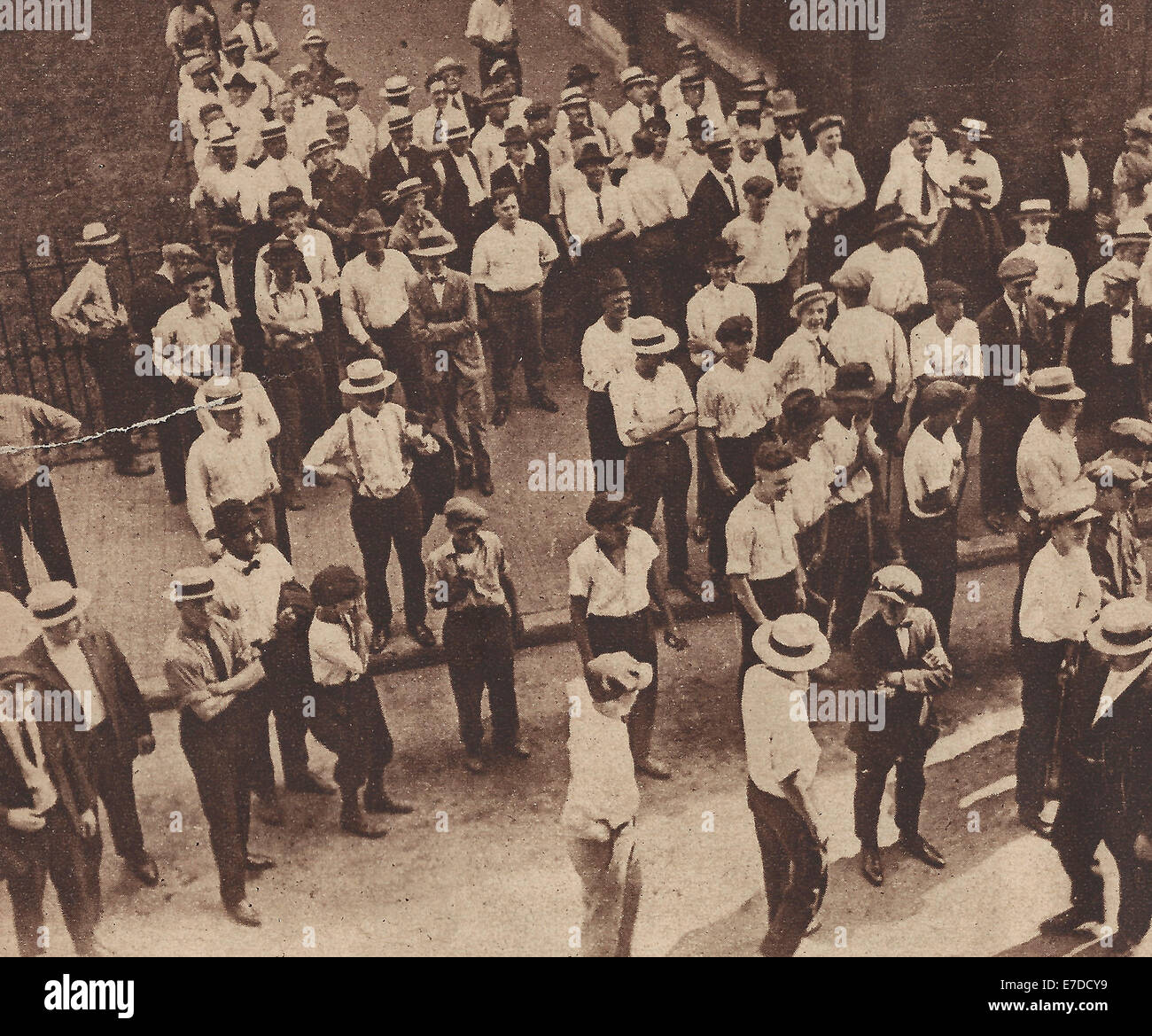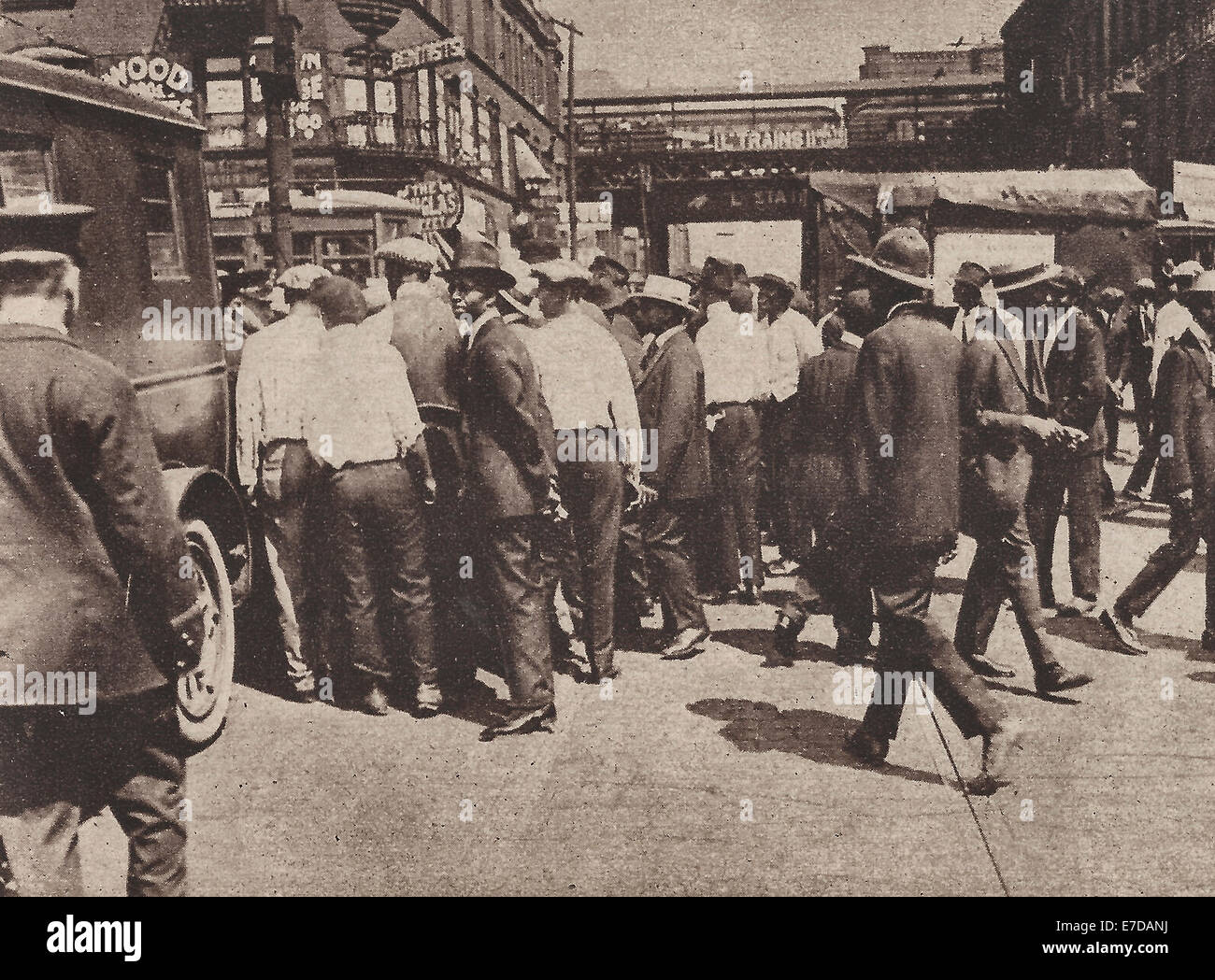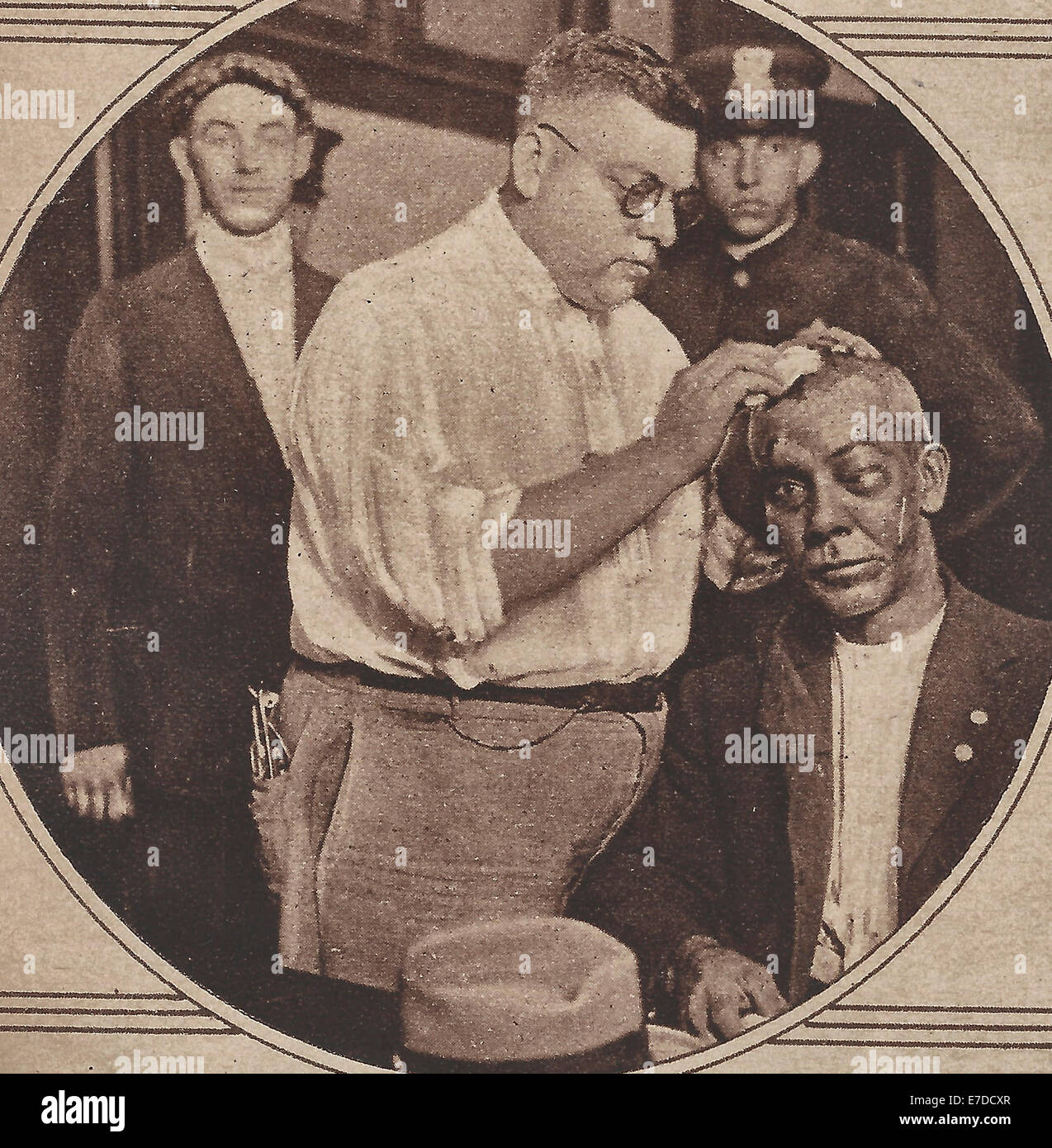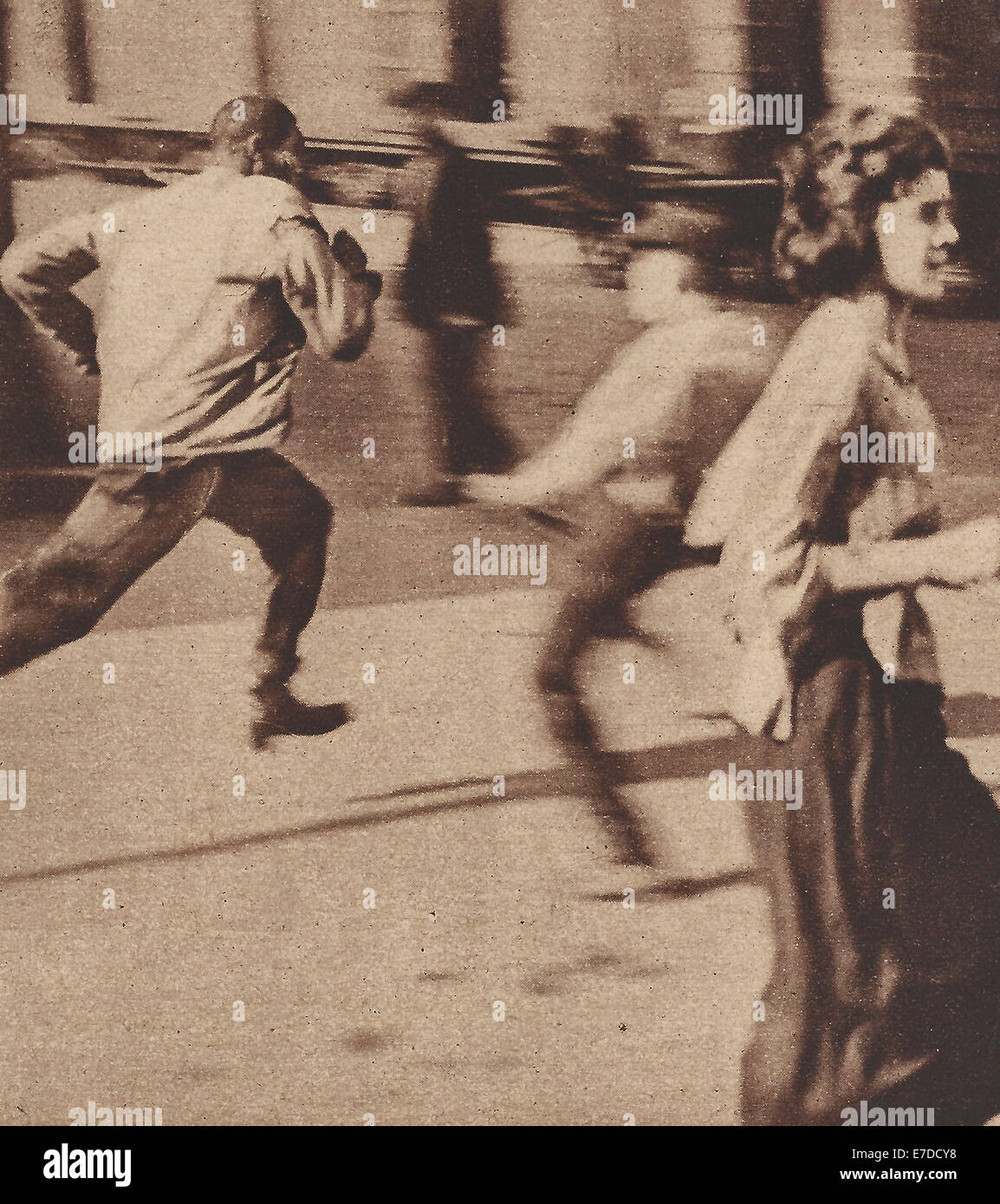"Ghastly Deeds of Race Rioters Told": The Chicago Defender Reports the Chicago Race Riot, 1919
For fully four days this old city has been rocked in a quake of racial antagonism, seared in a blaze of red hate flaming as fiercely as the heat of day—each hour ushering in new stories of slaying, looting, arson, rapine, sending the awful roll of casualties to a grand total of 40 dead and more than 500 wounded, many of them perhaps fatally. A certain madness distinctly indicated in reports of shootings, stabbings and burning of buildings which literally pour in every minute. Women and children have not been spared. Traffic has been stopped. Phone wires have been cut.
Stores and Offices Shut
Victims lay in every street and vacant lot. Hospitals are filled: 4,000 troops rest in arms, among which are companies of the old Eighth regiment, while the inadequate force of police battles vainly to save the city’s honor.
Fear to Care for Bodies
Undertakers on the South Side refused to accept bodies of white victims. White undertakers refuse to accept black victims. Both for the same reason. They feared the vengeance of the mobs without.
Every little while bodies were found in some street, alley or vacant lot—and no one sought to care for them. Patrols were unable to accommodate them because they were being used in rushing live victims to hospitals. Some victims were dragged to a mob’s “No Man’s Land” and dropped.
The telephone wires in the raging districts were cut in many places by the rioters as it became difficult to estimate the number of dead victims.
Hospitals Filled with Maimed
Provident hospital, 36th and Dearborn streets, situated in the heart of the“black belt,” as well as other hospitals in the surrounding districts, are filled with the maimed and dying. Every hour, every minute, every second finds patrols backed up and unloading the human freight branded with the red symbol of this orgy of hate. Many victims have reached the hospitals, only to die before kind hands could attend to them. So pressing has the situation become that schools, drug stores and private houses are being used. Trucks, drays and hearses are being used for ambulances.
Monday Sees “Reign of Terror”
Following the Sunday affray, the red tongues had blabbed their fill, and Monday morning found the thoroughfares in the white neighborhoods throated with a sea of humans—everywhere—some armed with guns, bricks, clubs and an oath. The presence of a black face in their vicinity was a signal for a carnival of death, and before any aid could reach the poor, unfortunate one his body reposed in some kindly gutter, his brains spilled over a dirty pavement. Some of the victims were chased, caught and dragged into alleys and lots, where they were left for dead. In all parts of the city, white mobs dragged from surface cars, black passengers wholly ignorant of any trouble, and set upon them. An unidentified man, young woman and a 3 month old baby were found dead on the street at the intersection of 47th street and Wentworth avenue. She had attempted to board a car there when the mob seized her, beat her, slashed her body into ribbons and beat the Baby’s brains out against a telegraph pole. Not satisfied with this, one rioter severed her breasts and a white youngster bore it aloft on pole, triumphantly, while the crowd hooted gleefully. All the time this was happening, several policemen were in the crowd, but did not make any attempt to make rescue until too late.
Kill Scores Coming from Yards
Rioters operating in the vicinity of the stock yards, which lies in the heart of white residences west of Halsted street, attacked scores of workers—women and men alike returning form work. Stories of these outrages began to fluster into the black vicinities and hysterical men harangued their fellow to avenge the killings—and soon they, infected with the insanity of the mob, rushed through the streets, drove high powered motor cars or waited for street cars which they attacked with gunfire and stones. Shortly after noon all traffic south of 22nd street and north of 55th street, west of Cottage Grove avenue and east of Wentworth avenue, was stopped with the exception of trolley cars. Whites who entered this zone were set upon with unmeasurable fury.
Policemen employed in the disturbed sections were wholly unable to handle the situation. When one did attempt to carry out his duty he was beaten and his gun taken from him. The fury of the mob could not be abated. Mounted police were employed, but to no avail.
35th Vortex of Night’s Rioting
With the approach of darkness the rioting gave prospects of being continued throughout the night. Whites boarded the platforms and shot through the windows of the trains at passengers. Some of the passengers alighting themselves from cars were thrown from the elevated structure, suffering broken legs, fractured skulls, and death.
The block between State street and Wabash avenue on East 35th street was the scene of probably the most shooting and rioting of the evening and a pitched battle ensued between the police, whites and blacks.
The trouble climaxed when white occupants of the Angelus apartments began firing shots and throwing missiles from their windows. One man was shot through the head, but before his name could be secured he was spirited away. The attack developed a hysterical battling fervor and the mob charged the building and the battle was on.
Police were shot. Whites were seen to tumble out of automobiles, from doorways, and other places, wounded or suffering from bruises inflicted by gunshots, stones or bricks. A reign of terror literally ensued. Automobiles were stopped, occupants beaten and machines wrecked. Street cars operating in 35th street were wrecked as well as north and south bound State street cars. Windows were shattered and white occupants beaten.
Trolley cars operating east and west on 35th street were stopped, since they always left the vicinity in a perforated state. Shortly after 8 o’clock all service was discontinued on 43rd, 47th, and 51st streets.
Stores Looted: Homes Burned
Tiring of street fights rioters turned to burning and looting. This was truly a sleepless night and a resume on the day’s happenings nourished an inclination for renewed hostilities from another angle. The homes of blacks isolated in white neighborhoods were burned to the ground and the owners and occupants beaten and thrown unconscious in the smoldering embers. Meanwhile rioters in the “black belt” smashed windows and looted shops of white merchants on State street.
Other rioters, manning high powered cars and armed, flitted up and down the darkened streets, chancing shots at fleeting whites on the street and those riding in street cars.
Toward midnight quiet reigned along State street under the vigilance of 400 policemen and scores of uniformed men of the 8th Regiment.
Rioting Extends Into Loop
Tuesday dawned sorrowing with a death toll of 20 dead and 300 injured. In early morning a 13-year-old lad standing on his porch at 51st and Wabash avenue was shot to death by a white man who, in an attempt to get away, encountered a mob and his existence became history. A mounted policeman, unknown, fatally wounded a small boy in the 48th block on Dearborn street and was shot to death by some unknown rioter.
Workers thronging the loop district to their work were set upon by mobs of sailors and marines roving the streets and several fatal casualties have been reported. Infuriated white rioters attempted to storm the Palmer house and the postoffices, where there are a large number of employees, but an adequate police force dispersed them and later the men were spirited away to their homes in closed government mail trucks and other conveyances. White clerks have replaced our clerks in the main postoffice temporarily and our men have been shifted to outlying postoffices. The loop violence came as a surprise to the police. Police and reserves had been scattered over the South Side rioting districts, as no outbreaks had been expected in this quarter. Toward noon stations therein were overwhelmed with calls.
Frederick Smith, 33 years old, who spent three years in the Canadian army overseas and bears three wound chevrons, was attacked by a mob of hoodlums as he was passing Harrison street on S. State street. Smith had just stepped from the train, here to visit relatives, and was wholly ignorant of the disturbance. Monroe Gaddy, 3712 S. State street, and Halbert L. Bright, 3005 S. State street both employees of the custodians office in the Federal building, were attacked and severely beaten by a crowd of whites at Jackson boulevard and S. State street.
Excitement ran high all through the day July 28. Groups of men whose minds were inflamed by rumors of brutal attacks on men, women and children crowded the public thoroughfares in the South Side district from 27th to 39th streets. Some voicing sinister sentiments, others gesticulating and the remainder making their way home to grease up the old family revolver.
Added to the already irritable feeling was the fact that some whites had planned to make a “fore day” visit to the South Side homes with guns and torches. This message was conveyed to a group of men who were congregated near 36th street, on State. I elbowed my way to the center of the maddened throng as a man with his face covered with court plaster recited the story of his experience at the hands of a mob which had pounced upon him unannounced at 31st street and Archer ave. His story proved convincing enough to hasten the death of Casper Kazzourman (Greek), a peddler who was struck down form his wagon in front of 3618 South State street. It was men from this crowd who stole silently away and knifed the peddler to death.
Bullets Fly Thick
But hell was yet to break loose, and by fate I was destined to be present. It occurred at Wabash avenue and 35th street at 8:10 o’clock at night, when over fifty policemen, mounted and on foot, while in the attempt to disperse a mob that was playing havoc with every white face, drew their revolvers and showered bullets into the crowd. The officers' guns barked for fully ten minutes. Seeing no way to escape and at the same time thinking of the obituary column, I immediately decided that my best move was to fall face downward to the pavement and remain there til the air cleared. This I did at the expense of a perfectly new “straw bonnet.” But it was worth it.
Four Wounded
During the reign of terror four citizens fell wounded; one a woman. She voiced her distress after a bullet had pierced her left shoulder. A man of slender proportions stumbled over my body in the hurried attempt to escape and plunged head first into the ground. A stream of blood gushed from a wound in the back of his neck. The bullet from an officer’s revolver had found its mark. Blood from his fatal wound trickled down the pavement until it had reached me and heated corpuscles bathed my left cheek as I awaited the cessation of hostilities. The pavement about me was literally covered with splintered glass which had been torn from a laundry window by the fusillade of shots, and several times I was tempted to brush the broken fragments from my back, when some had fallen, but I dreaded making a move. I had a reason. It was a case of eventuality, but not now.
Beads of perspiration rolled off my forehead as a bullet passed over the back of my coat, burning a path near the collar as it sped on its deathly mission. I arose reluctantly as a cop yelled: “Get up, everybody.” He said it in the 200-point type we use on the front page of extras. His command was obeyed.
The wounded were whisked away in automobiles to nearby hospitals for treatment. Shortly after the guns had ceased firing the telephone on the managing editor’s desk at the office tinkled. He answered.
“Have you heard of the shooting at 35th and Wabash avenue?” queried a mellow tone voice on the other end. The rejoinder came, evidenced in clear tones: "Yes, madam, a Defender reporter was passing. "




 the more things change.....
the more things change.....





